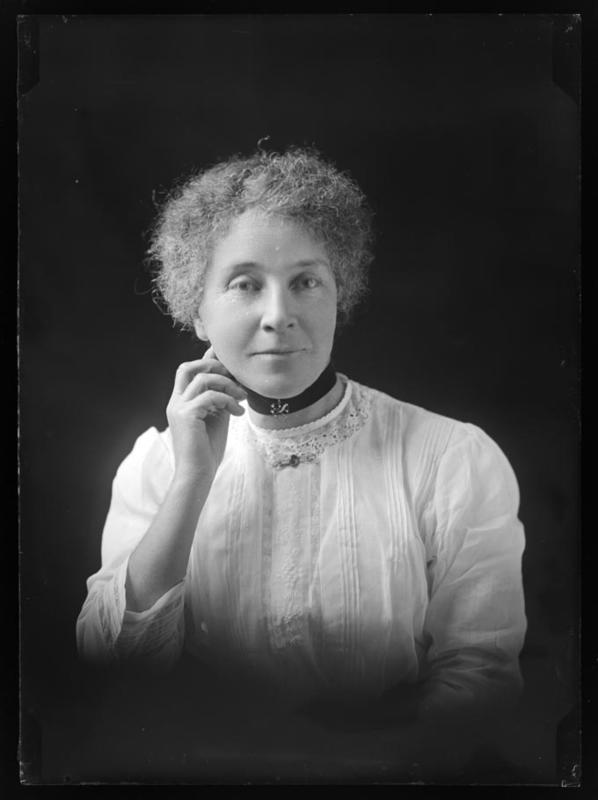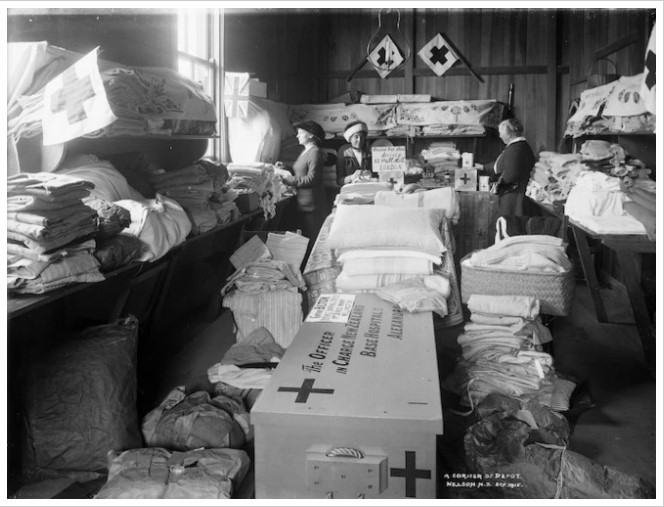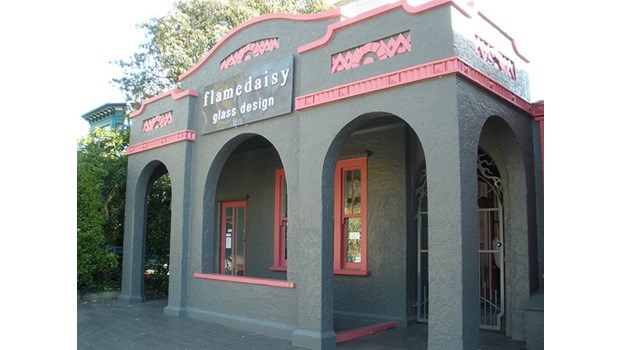Esther Lock
Esther Georgina Lock nee Levien came to public life in the shadow of her husband, William Lock, who was the 13th Mayor of Nelson, but she went on to establish a place for herself in the civic and community life of Nelson. Mrs Lock. Nelson Provincial Museum.
Esther Georgina Lock nee Levien came to public life in the shadow of her husband, William Lock, who was the 13th Mayor of Nelson, but she went on to establish a place for herself in the civic and community life of Nelson.
She first came to prominence in 1914, when, on the outbreak of World War 1, as the Mayoress, she established a committee of 43 local women to collect garments and funds to send to Great Britain for the relief of those affected by the War.1
When the need became more local with the dispatch of troops to the front, Esther presided over and participated in other charitable organisations. These were the Belgian Relief Fund, the Lady Liverpool Fund and the local Red Cross. In June 1915 when William was defeated in the mayoral race, a deputation of the Lady Liverpool committee asked her to stay on as chairwoman to which she agreed.2 For her work in the Belgium Relief Fund Esther was awarded the Queen Elisabeth Medal from the Belgian Government.3 In 1918 Esther was awarded an MBE by the British Government for her contribution to the war effort.4
With William being the Mayor again from 1921-1927, altogether Esther spent eight years as Mayoress and was one of the first ladies in the district to be appointed a Justice of the Peace, around 1926.5 She also gave long service to the Nelson Plunket Society. When she retired after five years as President in 1937, it was noted that she had been connected to the Society for 24 years and that the new Plunket and restrooms would be a monument to her memory.6
With the coming of World War II Esther was again involved in local relief work, notably on the Milk sub-committee of the Nelson Central Relief committee which supplied milk to young children.7 She was also involved with the Women’s National Reserve, urging women to take up jobs left vacant by enlisted and subscripted men,8 as well as the Nelson Health Camp Association and the Crippled Children’s Society.9
Esther appeared to retire from public life after 1945 owing to ill health, but continued to live in Nelson up until 1954, when she joined her daughter in Wellington, where she died in 1955.10 She is buried in Karori cemetery. Her name has been added to William’s headstone in Nelson’s Wakapuaka cemetery.
2022
Story by: Yolanda Persico
Sources
- For Those in Need (1914, August 11) Nelson Evening Mail, p.4
https://paperspast.natlib.govt.nz/newspapers/NEM19140811.2.22 - Lady Liverpool Committee (1915, June 16) The Colonist, p2 Supplement
https://paperspast.natlib.govt.nz/newspapers/TC19150616.2.55.14 - Supporting Belgium: Queen Elisabeth Medal. NZ History Online, Ministry for Culture and Heritage, updated 8-Dec-2020, p.5
https://nzhistory.govt.nz/war/supporting-war-effort/queen-elisabeth-medal - Mrs Lock Congratulated (1918, October 16) The Colonist, p.2
https://paperspast.natlib.govt.nz/newspapers/TC19181016.2.64.25 - General News (1943, December 14) Nelson Evening Mail, p.4
https://paperspast.natlib.govt.nz/newspapers/NEM19431214.2.64 - Fine Service for Plunket (1937, July 19) Nelson Evening Mail, p.2
https://paperspast.natlib.govt.nz/newspapers/NEM19370719.2.13 - Annual Meeting Nelson Central Relief Committee (1940, July 22) Nelson Evening Mail, p.2
- Street Appeal (1940, February 10) Nelson Evening Mail, p.6
https://paperspast.natlib.govt.nz/newspapers/NEM19400210.2.41 - Crippled Children Society (1944, September 13) Nelson Evening Mail, p.3
https://paperspast.natlib.govt.nz/newspapers/NEM19440913.2.22 - Death Notice (1955, August 23) Nelson Evening Mail, p.1
Further Sources
Websites
- Esther Georgina Lock, NZ History Online: Ministry for Culture and Heritage, updated 24-Feb-2017
https://nzhistory.govt.nz/media/photo/esther-georgina-lock - Esther Georgina Lock. Retrieved from Find a Grave, August 2022:
https://www.findagrave.com/memorial/163258274/esther-lock - Plunket and Rest Rooms. Heritage New Zealand. Retrieved August 2022:
https://www.heritage.org.nz/the-list/details/5169


